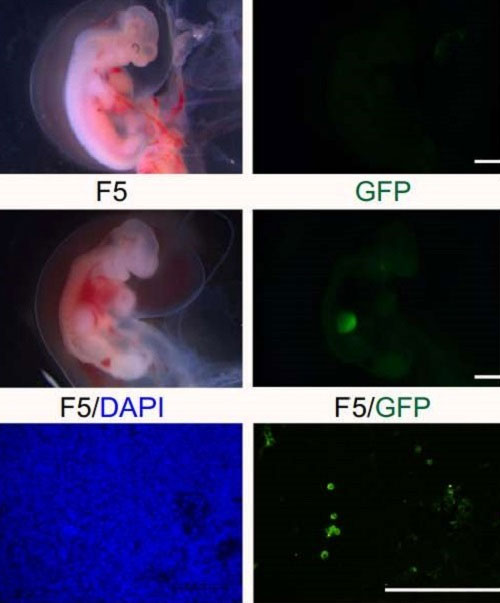China gave birth to a hybrid of pigs - monkeys
Scientists have successfully created pigs with monkey stem cells for the first time, approaching the goal of cultivating human organs in animals.

The monkey stem cells have been modified to luminesce to help researchers easily track the location.(Photo: IFL Science).
Pig-monkey hybrids are made up of at least two zygotes or eukaryotes formed during fertilization, containing basic DNA. The pig was born in the Laboratory of Stem Cells and Reproductive Biology, has a normal shape.
The team took embryonic stem cells from crab-eating monkeys, also known as long-tailed macaque, a species commonly used and propagated for biomedical research. These cells were genetically modified to produce a fluorescent protein called GFP so that researchers could track it after transplanting into pig embryos.
Only two of the 10 pigs born were hybrids, although the team implanted over 4,000 embryos. Monkey cells spread throughout the tissues of important internal organs like the heart, liver, spleen, lungs and skin, but only in small amounts (about 0.1 - 0.01%) of the total number of cells.
All 10 young pigs died within a week after birth, the cause of which is unknown. The team thinks that their deaths may be due to problems with in vitro fertilization (IVF) because both hybrid and non-hybrid individuals cannot survive. They are aiming to create healthy pigs with a higher proportion of monkey cells. If successful, the researchers plan to create pigs with internal organs composed of primates.
Human stem cells can regenerate on their own, opening the prospect of raising human internal organs in mammals for transplantation. Trials in rats have been relatively successful in producing hybrid organs, but this method is much more complicated when used in humans for biological and ethical reasons.
- Phu Tho: Successfully bred F1 F1 wild boars
- She gave birth to 3 grandchildren
- Scientists are creating hybrid animals between humans and monkeys in China
- Woman has 2 bodies in 1
- Appeared a mutated pig with a tap, an elephant-like ear
- Hybrid butterfly between two different species
- China deals with blue ear disease in pigs
- A Russian gave birth to 5 healthy daughters
- Mona Lisa just gave birth to a child while modeling
- The youngest mother in America gave birth
- Misunderstandings about pigs that people have
- Give birth to pandas
 13 causes of non-itchy rash
13 causes of non-itchy rash How the mouse with human ears changed the world?
How the mouse with human ears changed the world? The truth about 'fried rice syndrome!
The truth about 'fried rice syndrome! What is dental implant?
What is dental implant? Good news: New cancer drug discovered that causes cancer cells to 'starve'
Good news: New cancer drug discovered that causes cancer cells to 'starve'  Why do we get older when cells are always replicating?
Why do we get older when cells are always replicating?  Shocking Research: Human Memory Doesn't Exist Only in the Brain
Shocking Research: Human Memory Doesn't Exist Only in the Brain  Reasons for easy weight gain: Obesity has 'memory' and retains mechanisms in cells
Reasons for easy weight gain: Obesity has 'memory' and retains mechanisms in cells  What happens to cancer cells after they die?
What happens to cancer cells after they die?  New Breakthrough: 'Hack' Tumors, Turn Cancer Cells Into Pills
New Breakthrough: 'Hack' Tumors, Turn Cancer Cells Into Pills 